This was published 1 year ago
The next Japan: The hot new destination Aussies are flocking to
With K-pop idols, K-dramas and Oscar-winning films taking the world by storm, South Korea is becoming the region’s hottest destination.
By Chris Tharp
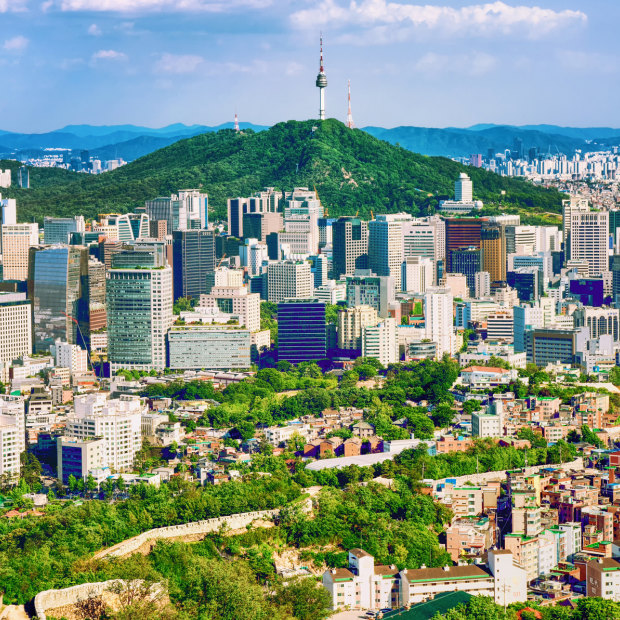
Seoul is the political, financial and cultural centre of the nation.Credit: iStock
Sticking out into the western Pacific like a rocky appendage, South Korea is one of the most rugged countries on Earth, with 70 per cent of its landmass made up of mountains. Once seen as a sleepy backwater, it has finally stepped into the spotlight, with an industrial, technical and pop-cultural output that boggles the mind.
Less than half the size of the state of Victoria, this densely packed nation of 50 million punches well above its weight when it comes to making things, especially the films, TV dramas and pop music that have captured the imagination of so many across the globe.
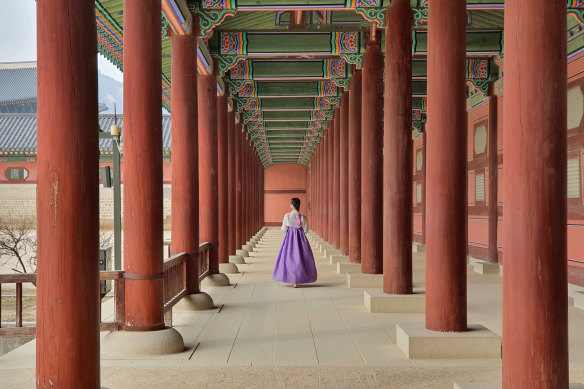
Gyeongbokgung Palace in Seoul.Credit: iStock
A visit to this vibrant country drives home just what a creative hub it is. Its cities are pulsating centres of neon-lights, humming footpaths, glimmering high-rises and street markets bursting with sights, sounds and aromas that entice and hypnotise.
That said, the nation is more than just bright lights and hyperkinetic urban modernity. Occupying the bottom half of the Korean Peninsula, South Korea is a land of sandy beaches, azure waters and more than 3300 islands. Much of its craggy landscape is blanketed in deep pine forests, and the countryside is home to timeless Buddhist temples, rolling hills, rice paddies and tranquil villages where – despite the trappings of modernity – the pace of life continues as it has for thousands of years.
Comparing the first quarter of 2023 to the same period in 2024, InsideAsia Tours has observed a staggering 58 per cent surge in South Korea bookings internationally. The Australia branch has experienced a 40 per cent increase – with that trajectory set to rise as awareness of South Korea’s appeal continues to grow.
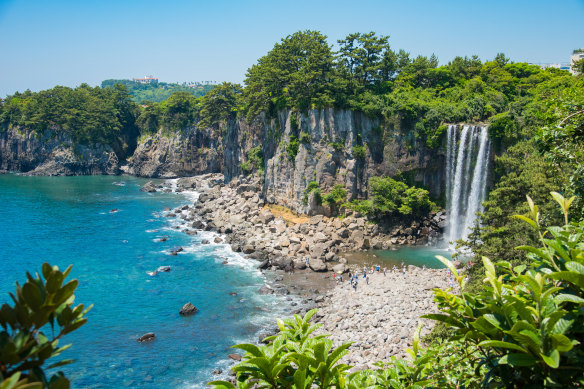
The Jeongbang Waterfall on Jeju Island falls directly into the sea.Credit: iStock
According to the Australian Bureau of Statistics, the number of Australian residents heading to South Korea over the past 12 months was 35 per cent above the pre-pandemic figures for 2019.
So now is the time to visit this dynamic, East Asian hotspot.
WHERE TO GO
Seoul
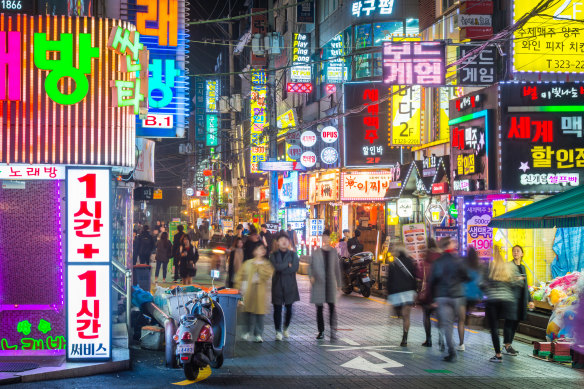
A Seoul kind of feeling... the bright lights of Sinchon, Seoul.Credit: iStock
Most international flights land at Incheon International Airport, which serves the capital, Seoul. The city’s greater metropolitan area is home to almost half of all of South Korea’s residents, and with good reason: Seoul is the political, financial and cultural centre of the nation. Most anything that happens in South Korea happens here first, and one walk down its buzzing streets reveals a city in constant motion, with packs of stylish young folks intermingling with colourfully clad older women and suit-and-tie salarymen enjoying a bottle or two of soju at outdoor tables after work.
K-pop blasts out from kiosks and mobile-phone shops, gruff street-food vendors tend their carts, and the smell of roasting coffee and sizzling barbecue fills the air. The city is also home to cool and quaint neighbourhoods, historic palaces and some of the most dazzling modern buildings in the country, including the Dongdaemun Design Plaza and the 123-storey Lotte World Tower – a gleaming architectural triumph overlooking the Han River and the twisting urban tapestry spread out below.
Rest up
Situated on the slope of Namsan Mountain, the Grand Hyatt Seoul (double rooms from $630; hyatt.com) offers an unbeatable central location and five-star sophistication without being stuffy or pretentious. Aloft Seoul Gangnam (doubles from $228; marriott.com) is a great choice for those seeking boutique chic in a neighbourhood synonymous with style, while – occupying the 76th to 101st floors of the Lotte World Tower – Signiel Seoul (double rooms from $560; lottehotel.com) sets the standard for excellence and modernity in a city already known to be on the cutting edge.
Gangwon-do
Now conveniently linked by the high-speed KTX train to the capital, Gangwon-do province is South Korea at its most outdoorsy. Host of the 2018 Pyeongchang Winter Olympics, this once isolated region has kilometres of empty beaches, thick forests, surging rivers and ski runs on the slopes of the mighty Taebaek range. This rugged ridge reaches its zenith at Seoraksan, the country’s third-highest, and arguably most beautiful peak, with a national park that overlooks the charming coastal city of Sokcho. Just down the road is laid-back Gangneung, renowned not just for its multitude of seaside cafes, but also Jumunjin Beach, where K-pop fans can pay their respects at what is now known as the “BTS Bus Stop”, the shooting location for the supergroup’s video, Spring Day.
Rest up
Overlooking Gangneung’s Gyeongpo Beach, the elegantly designed Seamarq Hotel (doubles from $650; seamarqhotel.com) is one of Gangwon’s premier luxury spots with everything you can expect from a top-tier hotel, along with jaw-dropping vistas of the East Sea. The Sea Cruise Hotel (doubles from $96; seacruisehotel.com) offers clean and comfortable business sensibility with a convenient downtown Sokcho location, while The House Hostel (dormitory beds from $20, double rooms from $39; thehouse-hostel.com) is immaculate, friendly and a great base for local explorations.
Gyeongju
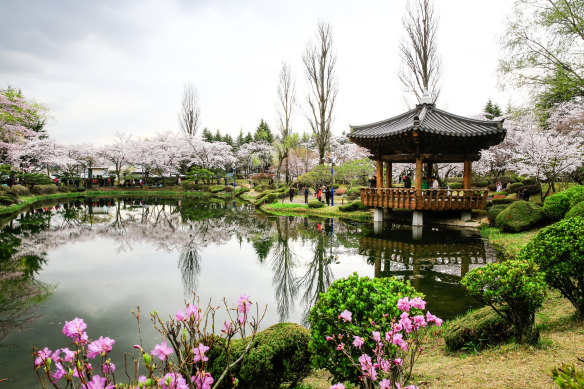
Cherry blossoms on a lake in Bomun, Gyeongju.Credit: iStock
Situated in the country’s south-east, South Korea’s most historic city is often described as a “museum without walls”, and is the perfect place to soak up the nation’s cultural heritage. Gyeongju was once the capital of the prosperous Silla Kingdom (57 BC-935 BC), which, for a time, ruled over most of the Korean peninsula. This placid town is home to colourful pavilions, stone pagodas, an observatory tower and scores of royal tombs, as well three UNESCO World Heritage Sites: Bulguksa Temple, Seokguram Grotto and Namsan Mountain.
Rest up
IJE Gyeongju (doubles from $523; stayfolio.com) is in the pine-forested shadow of Bulguksa Temple and sets the bar for class, amenities and relaxation in the ancient Shilla capital. Soi Hanok Stay (from $257; no website) honours Gyeongju’s rich architectural tradition while providing modern comforts in the heart of town, and the Lahan Select (doubles from $332; lahanhotels.com) looks out over placid Lake Bomun, with its shores that burst to life every spring when the cherry blossoms bloom.
Busan
No longer content to linger in the shadow of the capital, the country’s second city of Busan has come into its own, and is a must-visit on any South Korean itinerary. With mountaintop fortresses, towering high-rises, funky hillside neighbourhoods and beaches galore, scenic Busan is where Koreans come to have a good time.
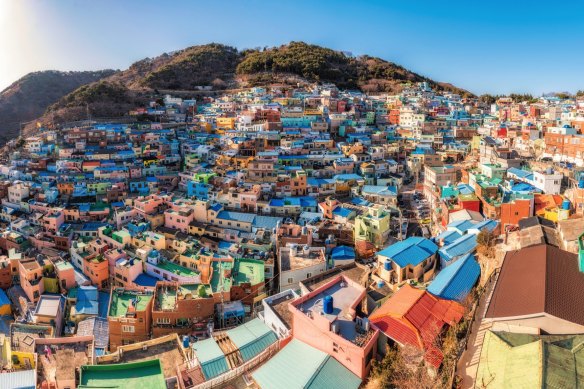
Gamcheon Culture Village in Busan.Credit: iStock
A raucous, port town at heart, the city also shows off its glamorous side every October, when it hosts Asia’s largest film festival. Busan’s proximity to the ocean guarantees that its markets and restaurants are teeming with the freshest of seafood, and dwaeji gukbap – the city’s hearty, signature pork soup – delivers a kind of savoury satisfaction unmatched anywhere else in the country.
Rest up
The Paradise Hotel (doubles from $360; busanparadisehotel.co.kr) sits right on Busan’s iconic Haeundae Beach and is famous for its spacious rooms, ocean views and rooftop pool. Just down the street is the Haeundae Seacloud (doubles from $85; haeundae-seacloud-residence.busan-hotel.com), which pulls off sleekness while also managing to be budget-friendly, and the Lotte Hotel in Seomyeon (doubles from $217; lottehotel.com) is a go-to for both business and holiday travellers due to its central location, comfort and services.
Jeju Island
While officially Korean, Jeju sometimes feels like another country. Dominated by the crater-topped rise of Hallasan – a 1947-metre extinct volcano that is also the country’s highest peak – the island’s subtropical climate means that it’s the only place where you’ll see palm trees.

Holiday isle … Jeju Island.Credit: iStock
With black-sand beaches, tangerine groves, crystalline waters and the traditional female divers called haenyeo, Jeju Island offers up a taste of Korea that is distinct from the mainland. Once the premier national honeymoon destination, the so-called “Hawaii of Korea” now draws those wishing to engage with nature, including surfers, birdwatchers and hikers hitting the Jeju Olle Trail, a 400-plus-kilometre walking path that rings the whole of the island.
Rest up
The Grand Chosun Jeju (doubles from $279; gjj.josunhotel.com) is the island’s premier accommodation, with multiple pools, top-tier restaurants and a gorgeous seaside location. The Bayhill Pool & Villa (from $298; bayhill.co.kr) offers stylish family rooms with private terraces and swimming pools, while Zen Hideaway (doubles from $245; zenhideawayjeju.com) delivers class, comfort and windswept tranquillity right at the ocean’s edge.
THE PRACTICALITIES
Getting there
Korean Air, Qantas, Jetstar, Asiana and T’way Air offer daily non-stop flights from Sydney to Seoul’s Incheon International Airport. Asiana flies Melbourne-Seoul several times weekly during the Korean summer.
Incheon International Airport sits about 48 kilometres west of central Seoul, though it’s connected to the city centre by the Airport Rapid Express (AREX), which will deliver you to Seoul Station in about 40 minutes. From there, the whole of the city is at your doorstep, as Seoul is served by an immaculate, world-class subway system of 23 lines. The AREX shuts before midnight, so if your plane arrives late, a good option is the late-night bus, with non-stop routes to Seoul Station, Dongdaemun, Gangnam Station and Jamsil.
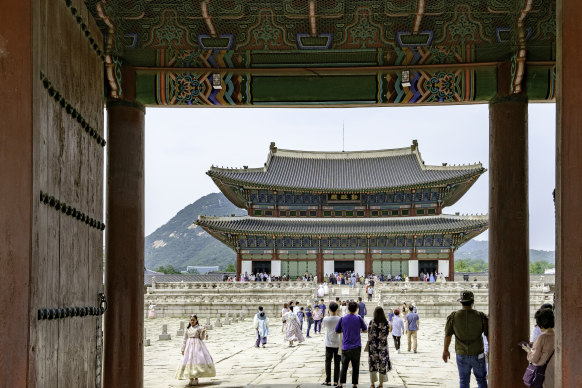
Gyeongbokgung Palace in Seoul.Credit: iStock
For greater convenience and comfort, you can also take a taxi. There are two main categories: standard and deluxe, and fares go up after midnight. While the language barrier can often be an issue, Incheon also has “international taxis” (intltaxi.co.kr), which cater exclusively to foreign visitors. These drivers will all speak at least basic English, though you’ll pay more for the privilege. Taxi fares vary depending on the type of cab, traffic conditions and the time of day, but expect to pay between $67-$125 to get to the city centre.
Hatching a plan
Like any trip planning, it’s best to book flights or travel package deals as far ahead as possible. Things are busiest in South Korea in the country’s summer months (roughly May-August), when many Koreans holiday domestically, so take that into account. Things can also get booked up around South Korea’s two major holidays: Chuseok (which falls in the northern hemisphere early autumn on the lunar calendar) and Lunar New Year (late January or February).
A season for everything
South Korea is a land of four very distinct seasons, and each has something to offer year-round. Still, the winters can be frigid and windy, while the summers are without fail hot and humid. Summer is also monsoon time, so from mid-June to the end of July, things are often quite wet, and August to September is typhoon season. This makes autumn and spring the ideal time to visit, with warm days, cool nights and weather that is rarely extreme.
Spend your won
While not a budget destination, South Korea doesn’t have to break the bank either. Things like food, transportation and even drinks can prove surprisingly inexpensive, and a relatively weak Korean won will guarantee that your dollar stretches far. Luxury hotels will set you back $400-$600 a night, while business and boutique hotel rooms can be had for a fraction of that.
Save your won
South Korea makes it very possible to do things on the cheap. The best way to save is to travel independently and book hotels on sites such as Booking.com or Agoda, where decent rooms can regularly be had for as little as $60 a night. Another option is staying at the ubiquitous “love motels” (they are what they say on the label, catering for couples living with their families in close confines who are wishing for a little privacy) which are almost always clean, comfortable and easy on the wallet, though they may allow smoking and don’t expect the owners to speak any English.
South Korea’s cities and towns are packed with great little family-run restaurants, making eating out surprisingly cheap. A home-style, filling meal will often set you back $10 or less. The country is also flush with convenience stores that offer coffee, cold drinks and loads of ready-to-eat food options, complete with tables and chairs inside and out front where you can sit and take down a quick meal.
While the high-speed KTX remains the most popular option for train travel, there are cheaper alternatives, including the ITX and Mugunhwa, the old-school train that – while slower – features roomier, fully reclining seats and even has tiny karaoke rooms where you can pass that extra time belting out your favourite tunes. The country is also served by an extensive network of intercity buses that – like so much in South Korea – are fast, efficient and affordable.
Know before you go
While South Korea is an extremely safe place when it comes to crime and public safety, it also occupies one of the last flashpoints of the Cold War. The country has been partitioned since 1945 and, while the Korean War ended with a ceasefire in 1953, a peace treaty was never signed. Over the decades there have been periodic flare-ups and provocations between the North and the South. While a large outbreak of hostilities is extremely unlikely, keep abreast of the news and check the Department of Foreign Affairs and Trade’s Smartraveller website; smartraveller.gov.au
Australian citizens are granted 90-day visa-free travel to South Korea without applying for an Electronic Travel Authorisation (K-ETA) visa. In 2024, South Korea launched its digital nomad visa, allowing visitors to stay and work in the country for up to two years.
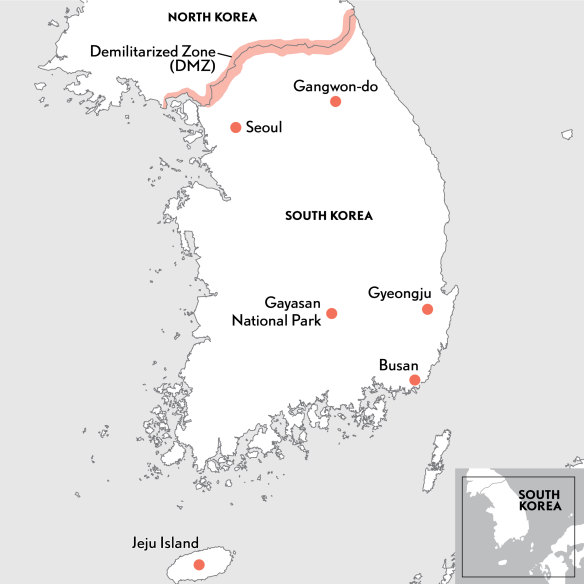
South Korea’s highlights.
Guiding lights: South Korea five ways
Dive into the capital
Wendy Wu Tours offers a short, private land-only tour for exploring Seoul. This includes accommodation, meals as listed in the itinerary and a local guide for touring. This four-day experience includes one full day of guided touring featuring Jogyesa Temple, Gyeongbok Palace, and seeing the Royal Guard Changing Ceremony. A day at leisure and airport transfers make this a hassle-free way to get to know the capital. From $975 a person twin share. See wendywutours.com.au
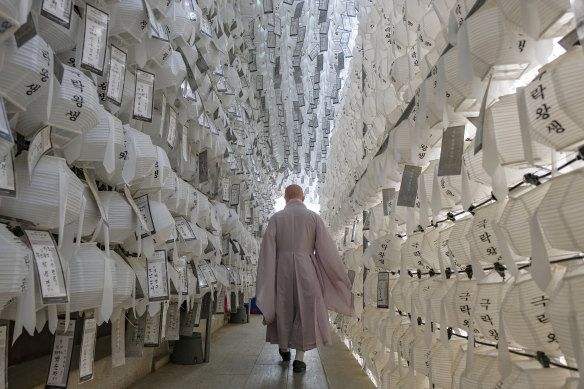
A monk at the Jogyesa Temple in Seoul.Credit: iStock
Explore the peninsula
APT’s 10-day Impressions of South Korea highlights Seoul, Busan and many points in between, including the DMZ, Gayasan National Park, and Gyeongju. You travel by rail and road and APT includes signature experiences such as private musical performances and traditional craft workshops. From $9495 a person, not including flights. See aptouring.com
Discover Jeju Island
South Korea’s largest island certainly warrants exploration, and InsideAsia has a Jeju Island Extension, which can be added to the company’s Self-Guided Adventures. It’s a four-day/three-night tour covering the island’s natural wonders with plenty of free time to explore more. It costs from $1718 a person based on three-star accommodation. There are four- and five-star options as well. See insideasiatours.com
Eat like a local
Headed up by longtime Seoul resident and veteran food writer Joe McPherson, ZenKimchi is all about delivering authentic dining experiences by avoiding the obvious tourist choices. Their most popular tours feature Korean pork barbecue as well as the raucous chicken and beer joints ubiquitous throughout the capital. Joe and company also lead full-day food tours and build custom itineraries. Prices vary, but food tours start from $163 a person for two. See zenkimchi.com
Head for the hills
As a nation of mountains, Korea is a trekker’s paradise, and New Zealander Roger Shepherd has been guiding clients up and down the ridges on both sides of the DMZ for more than 15 years now. Shepherd offers exclusive, top-end, expertly researched packages that not only include bagging some of Korea’s most iconic peaks, but also exploration of local temples and sites, along with down-home meals of great regional Korean fare. All itineraries are custom-created and prices differ based on numbers, days and other requirements. See hikekorea.com
The Telegraph, London